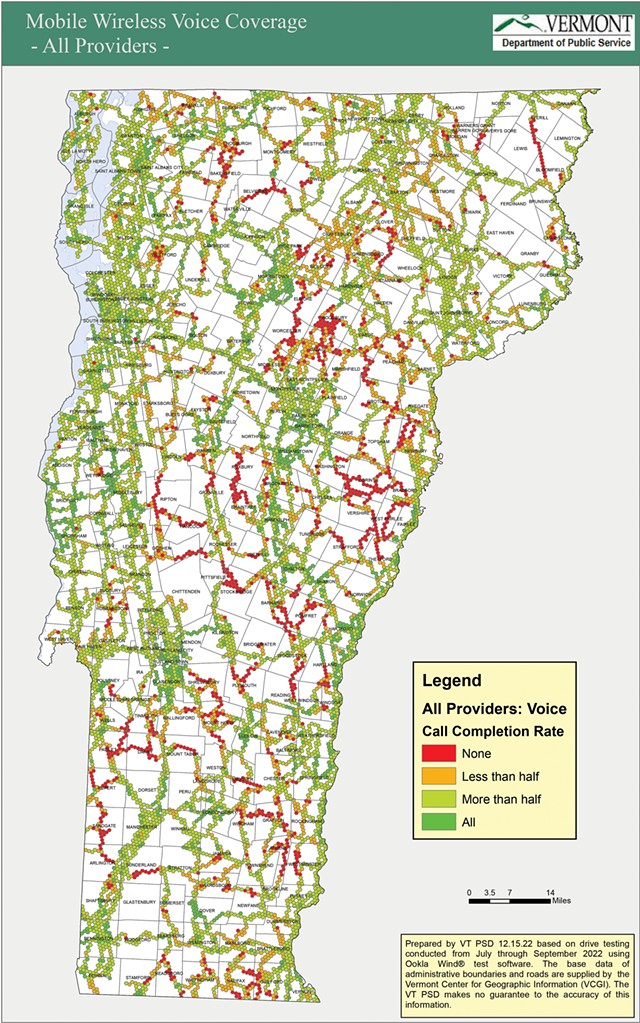
- State of Vermont
The interactive maps released by the Vermont Department of Public Service on Thursday show consumers which areas of the state are covered by the six available providers. That can help people choose the service that works best for them.
It will also help phone companies know where to direct their resources, according to Corey Chase, a telecommunications infrastructure specialist at the department who led the mapping project this summer.
“There are significant areas where voice service is lacking; everyone in Vermont knows that,” Chase said on Thursday. “This is demonstrable proof, and that’s a significant 911 problem.”
Related Can You Hear Us Now? 5G Tech Is Spooking Some Vermonters — Before It's Even Here

Can You Hear Us Now? 5G Tech Is Spooking Some Vermonters — Before It's Even Here
Tech
"We thought buildings were a more relatable statistic to use instead of road miles or area," he said.
Accordingly, the report divides the state into small hexagonal sections and compares the performance of six carriers in buildings within those sections.
The report shows wide variability between the carriers. AT&T was first when it comes to call reliability: 55 percent of the state's homes and businesses are in areas where AT&T calls can go through successfully. Another 8 percent of the buildings are in areas where most calls were completed.
By the same measure, FirstNet, which is used by first responders, follows AT&T with 53 percent. USCellular comes in at 47 percent; T-Mobile, 41 percent; VTel, 37 percent; and Verizon, just 26 percent.
Chase said he was surprised by the Verizon results. Many Vermont employees, including first responders, have Verizon service, he said.
"From our previous test and our own personal experience, we have had a sense that Verizon has similar if not better coverage than AT&T, and that is not borne out in the test," he said.
The report shows that there are nearly 50,000 buildings in the surveyed area where it's not possible to make calls with Verizon.
"That means there are 50,000 buildings where people don't have access to emergency services," Chase said. Phone service is more reliable in heavily populated areas such as Burlington, and it's spottiest in rural areas.
Some phone customers can use Wi-Fi to connect their phones at home and are most affected by lack of service when they are driving. But Chase noted many people don't have Wi-Fi at home and also rely on their mobile data to connect there.
"We get calls all the time from consumers who are livid that their phones don't work where they live," Chase said. "We hear, 'I live only two miles from the state capitol and I can't use my phone. What is wrong with this state?'"
Last winter, Gov. Phil Scott proposed spending $51 million in federal aid to expand cellphone service in Vermont, particularly in the rural areas where service is least reliable. Scott and Public Service Commissioner June Tierney said building 100 cellphone towers would help remote workers, the tourism industry and emergency responders, in particular. But lawmakers did not agree, and the proposal did not advance.
Jim Porter, director of the public advocacy division at the Public Service Department, said on Thursday that he doesn’t know whether the Scott administration plans to try again in the coming legislative session. Vermonters have made it clear in local meetings that they are ambivalent about building the towers, which can be 200 feet tall.
“I think people want cell service and they don’t want cell towers,” said state representative-elect Marc Mihaley, a Democrat who lives in Calais, speaking on his landline. He said a tower was proposed in Calais within the last six months but not approved.
Nearly five years ago, Chase drove a state-owned Prius 6,000 miles on Vermont roads for an earlier test of cellphone coverage and released a report in 2019. This year’s test was carried out by a contractor called Ookla and presented opportunities for Vermonters to provide data. The department and Ookla worked with drivers from the state Agency of Transportation who traversed 6,500 miles of Vermont roads between July 1 and September 15.
Chase said he hadn’t yet compared the results of the two tests, and the report released on Thursday doesn't include the data obtained through crowdsourcing.
“I haven’t had a chance to digest this fully, but what I see here is, there are significant areas where voice service is lacking,” he said. See related PDF Drive_Test_Map_2022.pdf





Comments
Comments are closed.
From 2014-2020, Seven Days allowed readers to comment on all stories posted on our website. While we've appreciated the suggestions and insights, right now Seven Days is prioritizing our core mission — producing high-quality, responsible local journalism — over moderating online debates between readers.
To criticize, correct or praise our reporting, please send us a letter to the editor or send us a tip. We’ll check it out and report the results.
Online comments may return when we have better tech tools for managing them. Thanks for reading.